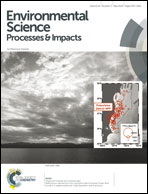Levels of flame retardants HBCD, TBBPA and TBC in surface soils from an industrialized region of East China
Abstract
Hexabromocyclododecanes (HBCDs) and tetrabromobisphenol A (TBBPA) are of increasing concern because of their potential environmental persistence, bioaccumulation and toxicity. Tris-(2,3-dibromopropyl)isocyanurate (TBC) is another brominated flame retardant (BFR) which has recently been found in the environment and begun to attract attention. The objective of this study is to determine the concentration of these three BFRs in surface soil samples collected from a heavily industrialized and urbanized region in East China. Levels of ∑HBCDs ranged from below detection limits (0.020 ng g−1) to 102.6 ng g−1 on a dry weight basis (dw) with a median level of 15.8 ng g−1 dw. For TBBPA, the concentration ranged from below detection limits (0.025 ng g−1) to 78.6 ng g−1 dw with a median level of 9.17 ng g−1 dw. TBC was found at relatively lower concentrations ranging from below detection limits (0.024 ng g−1) to 16.4 ng g−1 dw with a median level of 0.95 ng g−1 dw. The concentrations of these three BFRs are significantly positively correlated, indicating a common source. Variable BFRs levels were found in different types of soils, with significantly higher concentrations observed at waste dumping sites and industrial areas. The diastereoisomer profiles of HBCDs in most of the soil samples differed from those of the commercial products. The mass inventories of HBCDs, TBBPA and TBC in this region gave preliminarily estimates of 6.68, 2.67 and 0.85 kg, respectively. Therefore, the ubiquitous contamination of soils by these BFRs may well reflect their widespread usage in the study area.


 Please wait while we load your content...
Please wait while we load your content...